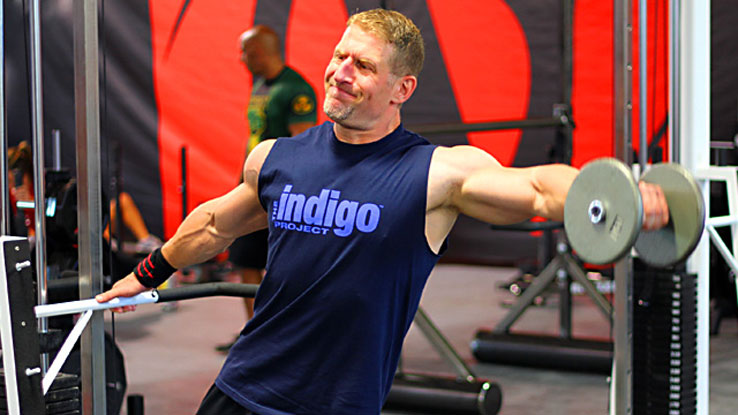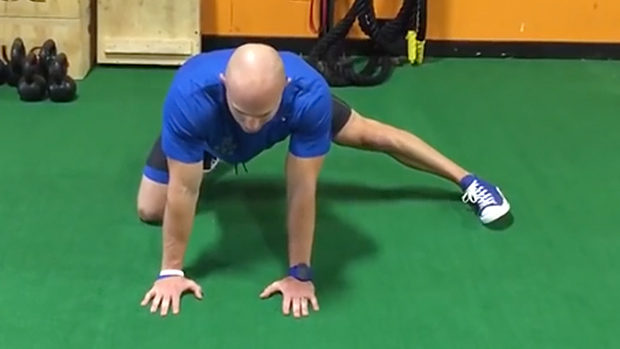The basic lifts are the cornerstone of a solid strength and hypertrophy program. But there comes a time when you need to make changes to keep the adaptation beast at bay. One of the best ways to spark new growth without completely overhauling your routine is by incorporating advanced exercise variations. Here are several that you can use immediately to boost your training progress.
Dr. Arthur Steindler introduced the concept of open kinetic chain (OKC) and closed kinetic chain (CKC) movements. An OKC movement is any movement where the terminal segment – the part of the extremity away from the center of the body – is free to move in space, like leg extensions. A CKC movement is any movement where the terminal segment is restrained against an immovable object or surface, such as squats.
Another way of defining these terms is that an OKC movement is where you move an object around your body. In a CKC movement you move your body around an object, or more specifically, around an immovable object or surface. So a lat pulldown would be considered an OKC movement and a pull-up a CKC movement.
It's far more neurologically demanding to move your body around an object rather than vice versa. For one, greater core stability is required, as you're probably not sitting down or lying on a bench. Of course, the other obvious factor is that a greater amount of bodyweight is being lifted. For these reasons, strength gained from a CKC movement will typically transfer to its OKC equivalent, but not vice versa.
For example, the average male lifter should easily be able to rep out on prone leg curls with 100+ pounds. Now ask that same guy to perform full range of motion reps on the Nordic hamstring curl with just his bodyweight and he'll struggle.
So the prone leg curl (the OKC movement) won't transfer to the Nordic hamstring curl (the CKC movement), but if you can increase your strength on the latter, it'll improve the former.
You can get stronger on the Nordic hamstring curl by using accommodating assistance from a lat pulldown machine. Here's how it works.
Kneel on the seat facing away from the machine and secure the back of your ankles against the knee support. Instead of using the high cable for assistance, use a resistance tube. Secure it on the machine itself or thread it through the high pulley attachment ring (just make sure to put the pin through the heaviest plate).
Now perform the exercise as you normally would from the ground while tightly holding the tube. As you descend further into the movement and take on more of your bodyweight, the tube will provide greater assistance. This converts a once almost-undoable exercise into a winner.
If you have a SITFIT available, use that to kneel on. It not only helps with comfort but also facilitates weight shifting and prevents you from sliding down the seat.
The reverse hyperextension is a great movement for the posterior chain. To really heighten the effect, you can use resistance bands to provide a greater overload where you want it and less where you don't.
The beauty of using elastic resistance rather than just weight plates is that you can really accelerate during the concentric action while maintaining contact with the ankle pad and without fear of sending the lever arm into orbit. The bands will then return the favor by trying to "fling" you back to the start position, which requires some braking action on your part. Thus, you get compensatory acceleration and compensatory deceleration each rep.
We know that a greater contribution of the supraspinatus is required during the first 15-30 degrees of the lateral raise and medial deltoid activity peaks at 90-120 degrees. So how do we use this info to our advantage?
Well, if you want to stress the supraspinatus fibers more, like during rehab from a rotator cuff repair, then overload the bottom range of the movement. This can be accomplished with side-lying dumbbell laterals done against a Swiss ball, an incline bench, or simply lying on the floor.
But if your goal is to build barn-door wide shoulders, then go with lean-away dumbbell laterals or tube laterals where you overload the top range.
For fun, combine them with dumbbells and use a jettison technique where you release the tube once you reach failure and continue with just the dumbbells until there's nothing left.
Most of the time, we train thinking of reps, but sometimes it's better to think of time under tension or TUT. Take the wrist roller exercise. I have people perform this on a high step to maximize the distance and we go for time. Sixty seconds is a good number to achieve on this one. It doesn't matter how many reps you do, at the 60-second mark you're done!
Another exercise where a TUT prescription is useful is the lower Russian twist. It's best to assign a time, like 30 seconds.
The typical side-lying dumbbell external rotation overloads the middle of the range. If you use a resistance tube, it overloads the end range. There's also a way to overload the start range. I learned it from shoulder specialist Dr. Dale Buchberger.
Simply lean back while performing a side-lying dumbbell external rotation. That way, a greater overload occurs in the start of the range. Inserting this movement periodically into your training will promote even strength development throughout the range of motion.
Here's an interesting movement I picked up from Yusuf Omar. Lie on the floor and cross your right leg over the left leg. Grab on to a low pulley D-handle with your right hand and perform one-arm cable flyes. It's a pretty wicked stretch near the bottom of the movement – a great way to "unwind," so to speak.
The reverse bench press can be a great triceps exercise. The big knock against it is comfort! It's not a "wrist-friendly" movement, especially under a heavy load, but there's a way to transform this into a winner. It's called the EZ-bar. Use it!
Take these variations out for a test-drive. You have nothing to lose and pounds of muscle to gain.




